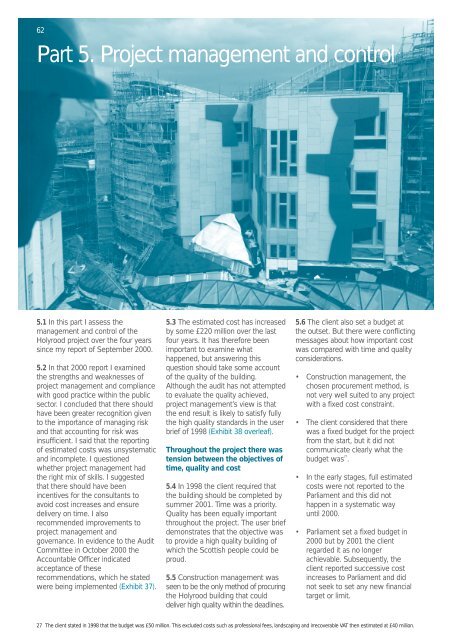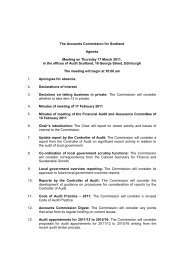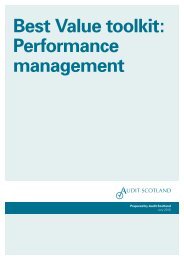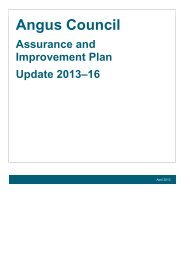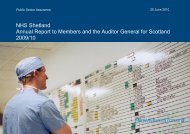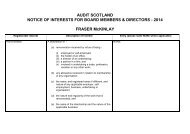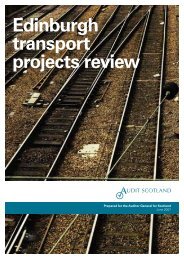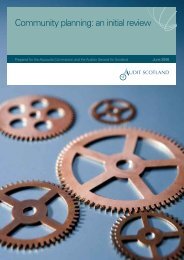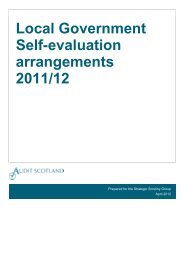Management of the Holyrood building project (PDF ... - Audit Scotland
Management of the Holyrood building project (PDF ... - Audit Scotland
Management of the Holyrood building project (PDF ... - Audit Scotland
Create successful ePaper yourself
Turn your PDF publications into a flip-book with our unique Google optimized e-Paper software.
62<br />
Part 5. Project management and control<br />
5.1 In this part I assess <strong>the</strong><br />
management and control <strong>of</strong> <strong>the</strong><br />
<strong>Holyrood</strong> <strong>project</strong> over <strong>the</strong> four years<br />
since my report <strong>of</strong> September 2000.<br />
5.2 In that 2000 report I examined<br />
<strong>the</strong> strengths and weaknesses <strong>of</strong><br />
<strong>project</strong> management and compliance<br />
with good practice within <strong>the</strong> public<br />
sector. I concluded that <strong>the</strong>re should<br />
have been greater recognition given<br />
to <strong>the</strong> importance <strong>of</strong> managing risk<br />
and that accounting for risk was<br />
insufficient. I said that <strong>the</strong> reporting<br />
<strong>of</strong> estimated costs was unsystematic<br />
and incomplete. I questioned<br />
whe<strong>the</strong>r <strong>project</strong> management had<br />
<strong>the</strong> right mix <strong>of</strong> skills. I suggested<br />
that <strong>the</strong>re should have been<br />
incentives for <strong>the</strong> consultants to<br />
avoid cost increases and ensure<br />
delivery on time. I also<br />
recommended improvements to<br />
<strong>project</strong> management and<br />
governance. In evidence to <strong>the</strong> <strong>Audit</strong><br />
Committee in October 2000 <strong>the</strong><br />
Accountable Officer indicated<br />
acceptance <strong>of</strong> <strong>the</strong>se<br />
recommendations, which he stated<br />
were being implemented (Exhibit 37).<br />
5.3 The estimated cost has increased<br />
by some £220 million over <strong>the</strong> last<br />
four years. It has <strong>the</strong>refore been<br />
important to examine what<br />
happened, but answering this<br />
question should take some account<br />
<strong>of</strong> <strong>the</strong> quality <strong>of</strong> <strong>the</strong> <strong>building</strong>.<br />
Although <strong>the</strong> audit has not attempted<br />
to evaluate <strong>the</strong> quality achieved,<br />
<strong>project</strong> management’s view is that<br />
<strong>the</strong> end result is likely to satisfy fully<br />
<strong>the</strong> high quality standards in <strong>the</strong> user<br />
brief <strong>of</strong> 1998 (Exhibit 38 overleaf).<br />
Throughout <strong>the</strong> <strong>project</strong> <strong>the</strong>re was<br />
tension between <strong>the</strong> objectives <strong>of</strong><br />
time, quality and cost<br />
5.4 In 1998 <strong>the</strong> client required that<br />
<strong>the</strong> <strong>building</strong> should be completed by<br />
summer 2001. Time was a priority.<br />
Quality has been equally important<br />
throughout <strong>the</strong> <strong>project</strong>. The user brief<br />
demonstrates that <strong>the</strong> objective was<br />
to provide a high quality <strong>building</strong> <strong>of</strong><br />
which <strong>the</strong> Scottish people could be<br />
proud.<br />
5.5 Construction management was<br />
seen to be <strong>the</strong> only method <strong>of</strong> procuring<br />
<strong>the</strong> <strong>Holyrood</strong> <strong>building</strong> that could<br />
deliver high quality within <strong>the</strong> deadlines.<br />
5.6 The client also set a budget at<br />
<strong>the</strong> outset. But <strong>the</strong>re were conflicting<br />
messages about how important cost<br />
was compared with time and quality<br />
considerations.<br />
• Construction management, <strong>the</strong><br />
chosen procurement method, is<br />
not very well suited to any <strong>project</strong><br />
with a fixed cost constraint.<br />
• The client considered that <strong>the</strong>re<br />
was a fixed budget for <strong>the</strong> <strong>project</strong><br />
from <strong>the</strong> start, but it did not<br />
communicate clearly what <strong>the</strong><br />
budget was 27<br />
.<br />
• In <strong>the</strong> early stages, full estimated<br />
costs were not reported to <strong>the</strong><br />
Parliament and this did not<br />
happen in a systematic way<br />
until 2000.<br />
• Parliament set a fixed budget in<br />
2000 but by 2001 <strong>the</strong> client<br />
regarded it as no longer<br />
achievable. Subsequently, <strong>the</strong><br />
client reported successive cost<br />
increases to Parliament and did<br />
not seek to set any new financial<br />
target or limit.<br />
27 The client stated in 1998 that <strong>the</strong> budget was £50 million. This excluded costs such as pr<strong>of</strong>essional fees, landscaping and irrecoverable VAT <strong>the</strong>n estimated at £40 million.


